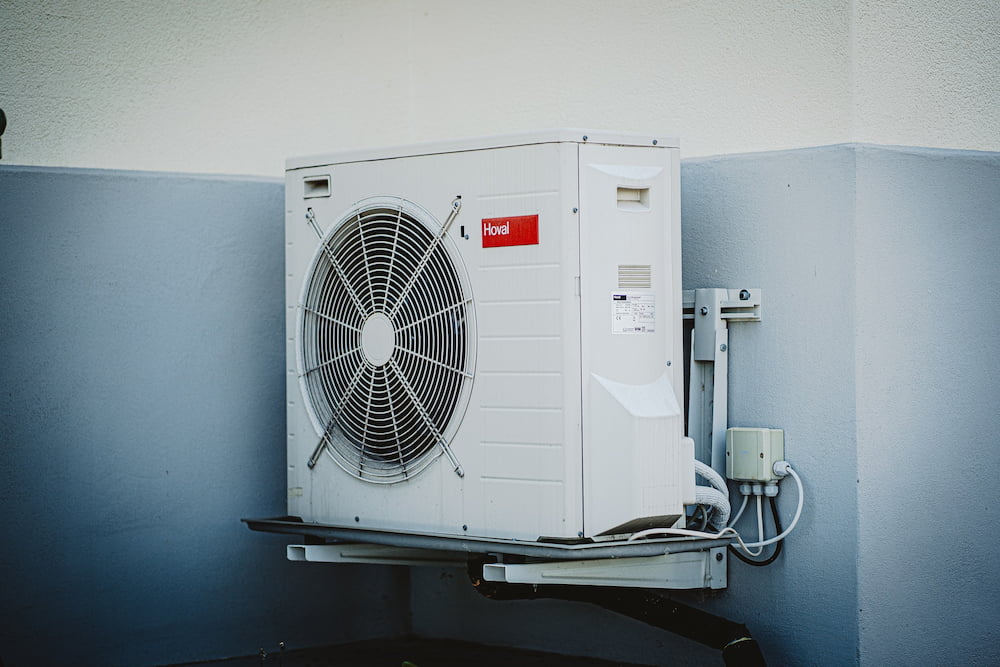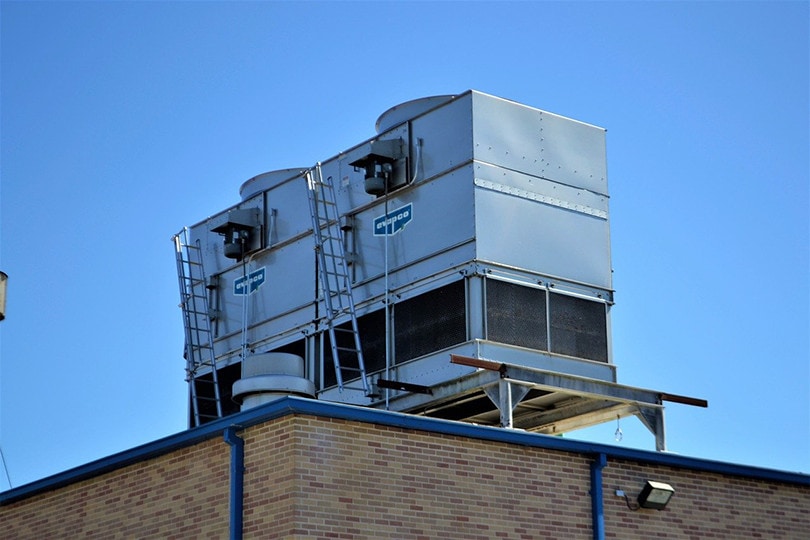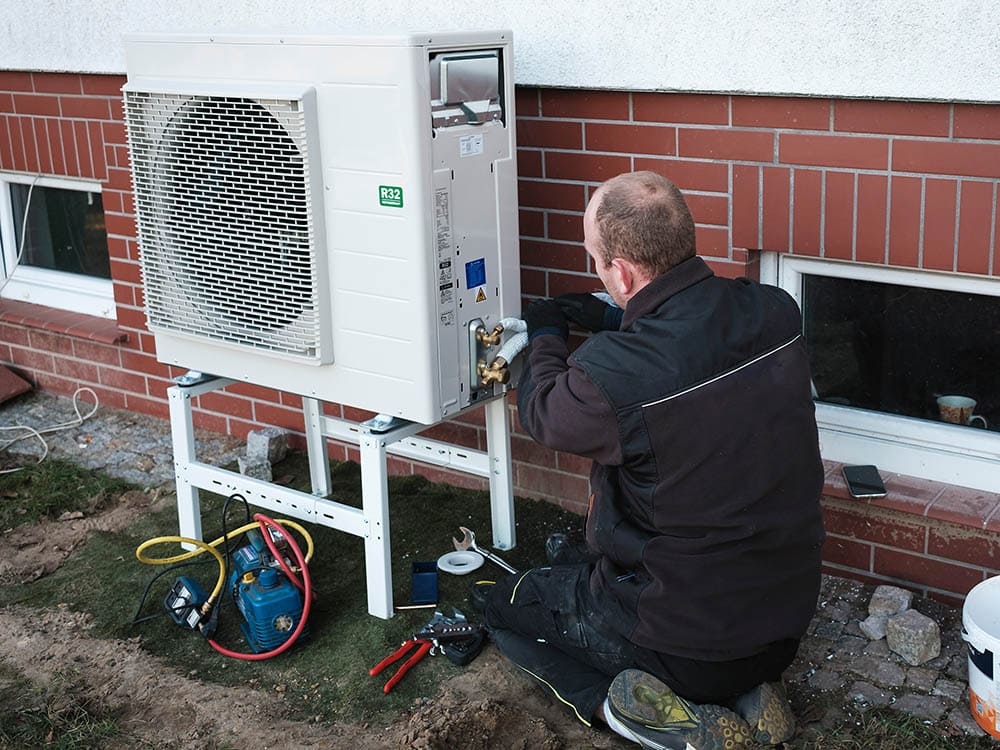What is a Mini Split Heat Pump & How Does It Work?
-
Greg Iacono
- Last updated:

A mini-split heat pump is a component of home heating and cooling systems made specifically for use where ductwork is not feasible or possible. The reason is that a mini-split heat pump (also called a “mini-split” or “zoned HVAC”) operates without the need for ducts.
Mini-splits provide a distinct advantage over ducted heating systems in that they eliminate the need to install ductwork and thus eliminate the installation labor and cost. They also provide several other advantages over traditional heating and cooling systems, as we will see below.
How Is a Mini-Split Heat Pump Installed?
Two components combine to form a mini-split heat pump: the air handling unit (installed inside the home) and the compressor/condenser (installed outside the home).
The air handling unit is typically installed near the ceiling in the room that needs to be heated or cooled. The reason is that the conditioned air will flow freely at this height without being blocked by furniture and other household items.
The air handling unit is connected to the compressor/condenser outside using a refrigerant line (rather than being connected by traditional ductwork). A power cable, condensate drain line, and suction tubing are also connected between the two main parts of the mini-split.
Several air handling units are attached to a single compressor/condenser. You can connect one compressor/condenser to a maximum of four air handling units.
All air handling units can be installed in different rooms and, most importantly, controlled independently of each other.

How Does a Mini-Split Heat Pump Work?
A mini-split heat pump is a marvel of engineering. It works by absorbing heat in the air using its compressor/condenser unit with the help of refrigerants.
Next, it transfers the absorbed heat to the air handling unit inside the home via the refrigerant line. The extreme cold of the refrigerant allows outdoor heat to be absorbed and transferred even on cold days.
What’s incredible about a mini-split heat pump is that, even if the temperature outside the home is at or below freezing, it still absorbs heat using the 2nd Law of Thermodynamics. This law states that heat will always flow from a warm body to a colder body.
The refrigerant is a key factor in the process, as it will still be colder than the outside air, even down to a temperature of -4 °F. When it’s colder, any heat in the outside air, even on a freezing day, will be absorbed and used to heat your home.
Also, the low temperature from where heat is absorbed (outside the home) is called the “source,” while the area being heated inside the home is called the “sink.” These can also be reversed, as we will see below.
- Related Read: 4 Interesting Heat Pump Facts
How Can You Create HVAC Zones With a Mini-Split Heat Pump?
A traditional HVAC system is usually designed to create “zones” in a home to allow it to be heated and cooled evenly. The problem is when one occupant in the house likes the temperature a little warmer, but another likes it a little cooler. In that case, it’s difficult to adjust the temperature to satisfy the needs of both.
With a mini-split heat pump, however, the above problem is solved. Each air handling unit can be adjusted independently, even though they are connected to the same compressor/condenser unit. This independency makes it extremely easy to create zones and even allows them to be on different floors.
For example, you could create one zone with an air handling unit in the living room/dining room. You can then create another in the kitchen, a 3rd in the master bedroom, and a 4th in the basement.

Do Mini-Split Heat Pumps provide Cooling Also?
Yes, mini-split heat pumps provide cooling as well as heating. If you recall, we mentioned earlier that the low temperature from where heat is absorbed is called the “source,” while the area being heated is called the “sink.”
When cooling your home, the source and the sink are, in effect, reversed. The room inside the home becomes the source of heat, and outside the home becomes the sink.
Thus, heat is absorbed inside the home and is transferred outside via the same refrigerant line. This has the effect of cooling the indoor space rather than heating it.
Since a mini-sink heat pump is fully reversible, switching it from heating your home to cooling is as straightforward as flipping a switch on the air handling unit’s remote control.
Advantages of a Mini-Split Heat Pump
Heating and cooling the air without ductwork is the primary benefit a mini-split heat pump provides. In a home or other location where installing ductwork would be complicated, impractical, or impossible, mini-split heat pumps are a feasible, more affordable solution.
Another benefit a mini-split heat pump provides is increased flexibility and improved convenience. For example, let’s say a homeowner wants t to increase the heat in their home office but doesn’t want to do the same in their entire home to save money on their energy bill.
With a mini-split heat pump, they can do exactly that by increasing the temperature in their office to stay comfortable while saving money by leaving the rest of the home at a lower temperature.
A further benefit of a mini-split heat pump is that, with several mini-split heat pumps in a single home, every family member can control the temperature in their private space. This individual control reduces arguments and makes for a more peaceful home life.
One final benefit of mini-split heat pumps is that they’re significantly more energy-efficient since they don’t have ductwork. Duct systems lose conditioned air through their various (and inevitable) gaps, cracks, and other openings.
The typical duct system can lose upwards of 30% of the conditioned air flowing through it, which is a large waste of energy. A lot of the conditioned air leaks out in places where it’s not needed, including attics and crawlspaces.
- Relatively easy installation compared to a traditional HVAC system
- No ductwork is necessary
- High flexibility with placement, zones, and temperature control
- Can be used for heating and cooling
- Can be installed very quickly
- Safer than window-installed units
Disadvantages of a Mini-Split Heat Pump
While mini-split heat pumps provide several excellent benefits, they also have one or two disadvantages. The first is that the upfront cost for a mini-split heat pump system is, in many cases, higher than a traditional HVAC system. Another problem is that the air handling unit installed in the home is unsightly. Also, a mini-split heat pump will need to be installed by a professional, but this is more a reality than a disadvantage.
- A higher upfront installation cost than most traditional heating and cooling (HVSC) systems
- Some may object to the look of the air handling unit

Mini-Split Heat Pump Terms to Know
When considering a mini-split heat pump for your home, it pays to know some of the terms professionals use. That way, you can make an educated decision when purchasing a new unit. Below are some of the most important terms:
- Heat pump: This term implies that your mini-split system can both heat and cool your home.
- Air handling unit: This unit is installed in your home to provide heated or cooled air.
- Condenser: This outdoor unit uses high-pressure and refrigerant to facilitate heat transfer.
- Compressor: The compressor works with the condenser outside and controls the pressure of the refrigerant. Both condenser and compressor are combined in one outdoor unit
- BTU (British Thermal Unit): A BTU is a measure of heating and cooling capacity, and the higher it is, the more heating and cooling power your mini-split heat pump will have. Mini-split heat pumps range from 9,000 BTU to 24,000 BTU.
- SEER: This stands for Seasonal Energy Efficiency Ratio. The higher the SEER a mini-split heat pump has, the more energy-efficient it will be. Typically, mini-split heat pumps have a SEER rating of 16 but can go up to 20 SEER.
 Final Thoughts
Final Thoughts
There’s no denying the benefits a mini-split heat pump delivers in various situations. With no ductwork needed, they are much easier to install. More importantly, mini-split heat pumps provide genuine comfort flexibility, allowing everyone in the family to set their own temperature.
Since they’re sleek, easy to control, and economical, mini-split heat pumps are an excellent solution to many home heating and cooling challenges. When searching for a cooling and heating system, savvy homeowners should consider installing a mini-split heat pump.
See also:
- How Often Should You Clean an AC Filter, Drain Line, and Coils?
- When Is the Best Time to Buy an Air Conditioner?
- https://www.servicechampions.net/blog/how-ductless-mini-split-work/#
- https://sealed.com/resources/winter-heat-pump/
- https://d-airconditioning.com/blogs/news/112886661-15-key-ductless-mini-split-terms-you-should-know
- https://www.lennox.com/buyers-guide/guide-to-hvac/glossary/condenser-coil
- https://danasheating.com/what-does-ac-seer-mean/#
- https://www.energy.gov/energysaver/ductless-mini-split-heat-pumps
- https://www.fujitsugeneral.com/us/residential/what-is-a-mini-split.html
Featured Image Credit: Carlos Lindner, Unsplash
Contents

